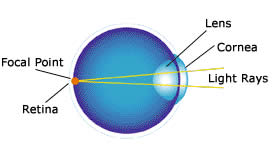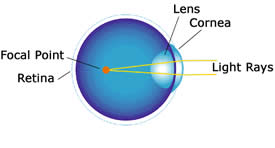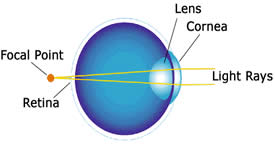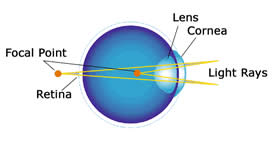
For many people, the focusing process does not work properly and images are not clear when viewed.
Often, blurred images are caused by nearsightedness, farsightedness, and astigmatism. When seeing up close requires bifocals or reading glasses, the condition is presbyopia.
Your vision works like a camera. Light enters the eye through the cornea and the lens. The cornea and the lens focus the light rays from the object viewed onto the retina. The retina receives an image from the incoming light rays and sends it to the brain through the optic nerve.
Nearsightedness (Myopia)

Light rays focus in front of the retina

Near by images are clear
Farsightedness (Hyperopia)

light rays focus behind the retina

Far away images are clear
Astigmatism

light rays focus on more than one point on the retina

Images are blurry
Presbyopia
As part of the natural aging process, your lens loses its ability to focus. It cannot change shape as easily, and it is more difficult to read at close range. Presbyopia affects everyone, beginning between the ages of 40 and 50.
Currently, there are no proven surgical techniques to correct presbyopia. However, for some people, monovision is an option. The laser is used to correct one eye for distance and the other eye for close-up vision. If you are considering monovision, talk to the Flaum Eye Institute Refractive Surgery Center team at the time of your evaluation, and we will help you decide by simulating monovision for you.